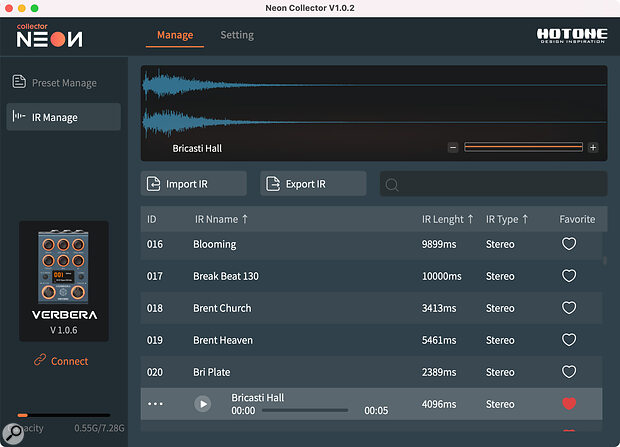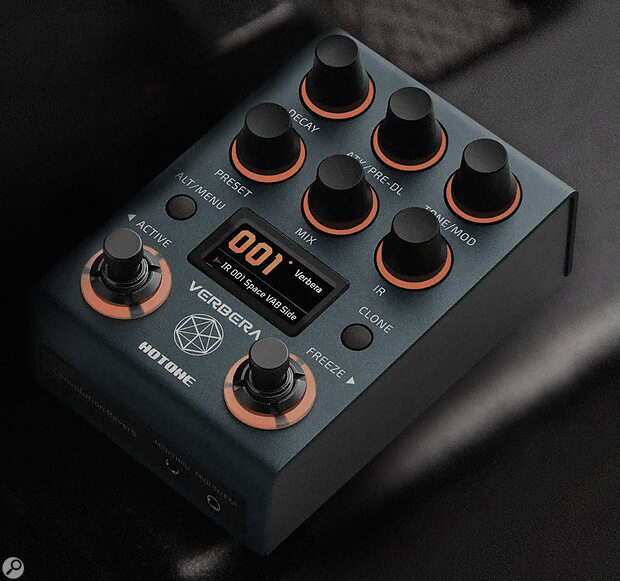Not only does this compact pedal offer convolution reverb — it can also capture impulses from your hardware 'verbs or room mics.
Yes, I know... the world already has plenty of reverb pedals! But Hotone’s Verbera takes a somewhat different approach from most, as it’s based on a convolution reverb engine. Guitarists may be familiar with convolution processing, which uses impulse responses (IRs), for speaker simulation, but convolution reverbs require longer IRs, and while they’re now common in the DAW plug‑in world, they’re pretty rare when it comes to physical stompboxes.
Overview
The Verbera is a fairly compact pedal, featuring six knobs, two buttons and two footswitches. Two of the knobs (Preset and IR) are push/turn encoders, and one button doubles as Menu and Alt, allowing the knobs to take on alternative functions. The knobs are labelled Decay, Atk (attack)/Pre‑delay, Tone/Mod, Preset, Mix, and IR. The second button is intriguingly labelled Clone — I’ll come back to that.
Coloured LED rings around each knob light up orange, but when Alt is engaged the relevant knobs display turquoise rings. A small colour display shows the preset name by default, but this flips to showing function and value when a control is adjusted. The dual footswitches handle bypass (which can be set to buffered or true bypass) or preset up/down in one mode, or to bypass plus a Freeze effect when in Control mode. Presets can be selected directly by using the Preset encoder, with the display showing the current preset name as well as those immediately before and after it in the preset list. Up to 200 presets (100 factory and 100 user) can be stored, and a free desktop app called Neon Collector handles preset and IR management, including the import of third‑party IRs. The Verbera supports third‑party IRs at 24‑ or 32‑bit wordlengths, and 44.1, 48, 96 or 192 kHz sample rates.
 The Neon Collector app, which handles preset and IR management, the import of third‑party IRs, and firmware updates.
The Neon Collector app, which handles preset and IR management, the import of third‑party IRs, and firmware updates.
The input is on a quarter‑inch TRS jack that accepts mono or stereo signals. The stereo output is presented on two quarter‑inch jacks or, alternatively, a single TRS output jack can carry the stereo...
You are reading one of the locked Subscribers-only articles from our latest 5 issues.
You've read 30% of this article for FREE, so to continue reading...
- ✅ Log in - if you have a Digital Subscription you bought from SoundOnSound.com
- ⬇️ Buy & Download this Single Article in PDF format £0.83 GBP$1.49 USD
For less than the price of a coffee, buy now and immediately download to your computer, tablet or mobile. - ⬇️ ⬇️ ⬇️ Buy & Download the FULL ISSUE PDF
Our 'full SOS magazine' for smartphone/tablet/computer. More info... - 📲 Buy a DIGITAL subscription (or 📖 📲 Print + Digital sub)
Instantly unlock ALL Premium web articles! We often release online-only content.
Visit our ShopStore.

